
Date: 2025-04-06 Page is: DBtxt003.php txt00019701
Military - Navy
Compaative Power
What countries in Europe have the most powerful navy right now (preferably in order)?
Peter Burgess
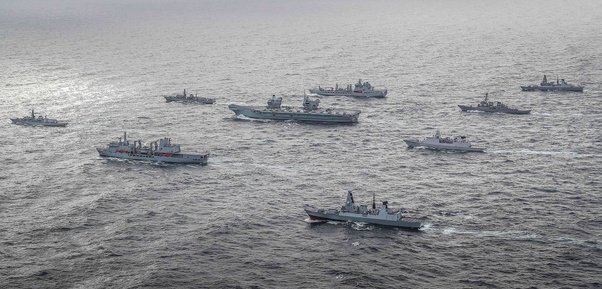
Amphibious Warfare: 5 LPDs/LSDs along with 4 Ro-Ro transport vessels. Supported by auxiliaries they are able to deploy a strong amphibious ready group though it lacks airborne support. Air Defence: 6 specialist Air Defence Destroyers, 2 carriers carrying 2–3 squadrons of stealth aircraft with basic AEW support. Likely the most capable Navy in air defence by a significant margin. Anti-Submarine: 8 reasonably modern ASW frigates, two carriers with both regularly embarking anti-submarine helicopter squadrons. Large fleet of highly advanced ASW helicopters. The UK is currently at a bit of a transitioning point with the Type 23s still in service, though they have been upgraded. It is at conflict with several other nations currently for the first spot though it will undoubtably take it eventually at least for a short time when the Type 26s are introduced. Land-Attack: Currently the UK has some of the most capable land attack capabilities. It has 7 SSNs capable of carrying dozens of tomahawk cruise missiles with 8 T26 frigates planned which will regularly carry some cruise missiles. For now, though, the primary land-attack asset is the carriers which can provide a large scale of sustained strike missions. Anti-Ship: 7 of the modern attack submarines - 4 Astute-class are likely the most advanced among these fleets with three more to come. Other ships have basic anti-ship capability and the carrier will eventually have long range cruise missiles but for now they are relatively limited with guided bombs, their main focus on air superiority. General Patrol: 5 GP frigates for power projection and global presence; various small inshore patrol craft and 8 larger OPVs. Of these, 3 smaller models are used for fishery protection while 5 larger models are spread between patrol missions in the South Atlantic, Caribbean, Mediterranean as well as UK waters. Auxiliary: By far the largest and most advanced of all the nations in Europe with 6 large fleet tankers, 3 replenishment vessels and several additional support ships. Marine Nationale (France) Summary: France has a strong airborne capability with a modern CATOBAR carrier and multiple LHDs while it has a strong local patrol fleet, however it is slightly limited in consistency for power projection.
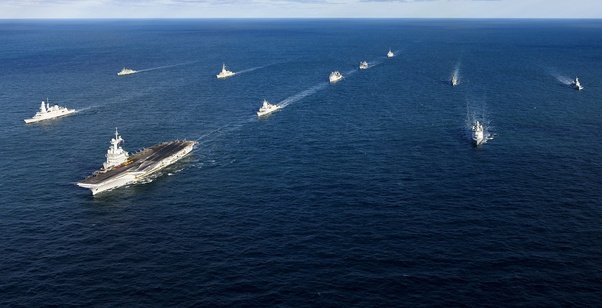
Amphibious Warfare: 3 LHDs but no additional assets. Small overall numbers but high quality and strong airborne strength. Air Defence: 2 specialist Air Defence Destroyers, 1 carrier with 2 squadrons of conventional aircraft with advanced AEW support. Very capable but limited by the fact its main asset (its carrier) is only available half the time. Small number of AAW escorts which mostly accompany the carrier. Anti-Submarine: France has a very advanced frigate fleet with 8 modern FREMM frigates. With the Type 26s not arriving in full for another 10–15 years, these are the most modern class of ASW specialists in service currently. Their general purpose La Fayette frigates also have decent ASW capability with their own towed sonars however where France is a bit weak is in its airborne ASW capabilities. I am excluding their maritime patrol aircraft as for some nations like Britain they are in the Air Force so it would be an unfair comparison but for ASW carrier capabilities, both QE-class embark a squadron of Merlins. France does not have such large and numerous ASW helicopters and does not embark them on its carrier or LHDs, though they could be reconfigures as ASW carriers. It is a bit weaker on submarines too but both nations are quite close for now. Land-Attack: Until the QE-class are fully operational France still has an edge of carrier-borne strike capabilities. Its current class of submarines do not carry cruise missiles (though the replacements will) so they are falling short of the UK in that respect, however they already have surface-launched cruise missiles from FREMM which the UK in turn is only just introducing in the 2020s. Anti-Ship: France’s warships all have reasonably modern variants of the Exocet anti-ship missile and they will use Sea Venom on helicopters so they have decent defensive capabilities. For offensive anti-ship operations, 6 submarines against the UK’s 7. France’s are about a third of the size of the more modern Astute-class and probably have less modern stealth capabilities, though it is equal if not superior to the Trafalgar-class being phased out. With a shorter range and capacity, they are limited but still very capable. Where they step ahead is in carrier aircraft as the Rafaela is reasonably capable in an anti-ship role and they have Hawkeyes to provide long range reconnaissance. The UK lacks these capabilities until SPEAR 3 or Brimstone are introduced on their jets. General Patrol: France probably has the strongest patrol fleet in Europe, including many ‘aviso’ type ships and other other patrol vessels. With larger frigates it has 5 basic GP frigates like Britain, however the La Fayette class are generally more sophisticated for now and have better specialised capabilities. Auxiliary: France’s main limiting factor is its small auxiliary fleet of just 3 18,000t tankers. These are enough to support a carrier strike group on occasion and a regular LHD and its support but due to the small size (compared to a UK CSG with a 40,000t tanker and 25,000t stores ship, for example), it doesn’t allow much flexibility for other sustained overseas operations. Marina Militare (Italy) Summary: Italy is growing to become one of the largest navies in Europe while remaining one of the most advanced too. It has two light carriers that allow permanent expeditionary capability though due tot he smaller scale, it is mostly retained to nearby seas.
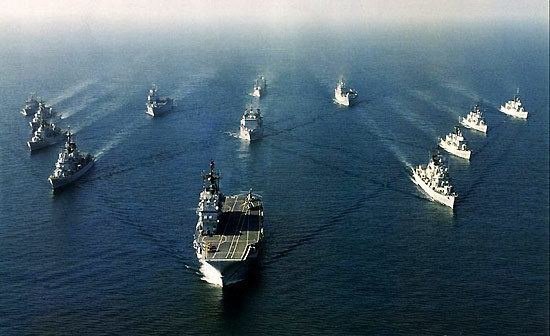
Amphibious Warfare: With Trieste just coming into service alongside three light LPDs, Italy has are reasonably capable amphibious force which will improve substantially in a few years as the old San Giorgio class are swapped out with ships twice their size. It also has a very large helicopter force to transport them. Air Defence: Though Italy only has two modern Horizon-class destroyers in service, unlike France it is not stuck with only two escorts as it still has two older vessels which will soon be replaced by a pair of far larger and more modern warships in a few years. Many frigates also use Aster 30s and Italy has two light carriers which are able to deploy a squadron of F-35Bs (just transitioning out of harriers) which give it some of the most capable air defence on the list. Anti-Submarine: The Italian Navy once again has an extremely capable helicopter force to support its large surface fleet that only continues to expand with its carrier vessels also regularly embarking anti-submarine helicopters. For submarines it has eight submarines - four are older but will be replaced with the same modern class as the other four. Land-Attack: Though their submarines have some German short-range cruise missiles coming into service, the main land-attack capabilities come from surface ships with long range cannons, cruise missiles and carriers with multirole jets. Anti-Ship: Italy still maintains a strong anti-ship fleet with numerous surface vessels armed at a basic level and a large submarine fleet. The combat aircraft also have basic anti-surface weapons that can be sued against surface vessels. General Patrol: Italy’s patrol fleet is massive with numerous small and medium sized patrol craft in addition to 4 GP frigates. In a few years the main 12 GP frigates and corvettes will be replaced by a new class of 16 warships, all essentially heavily armed general purposes frigates with long range air and submarine defence in addition to land attack capabilities. Auxiliary: Italy has another small auxiliary force for its navy with only three small tankers (about 10,000t each, give or take) though these are supplemented by a number of small coastal tankers and transport vessels to support them. It will grow further in the future as larger tankers will be introduced. Armada Española (Spain) Summary: Spain is one of the middling powers here with some modern capabilities in air and submarine defence alongside a basic expeditionary force, however it is not as large as Italy or as advanced as France or the UK.
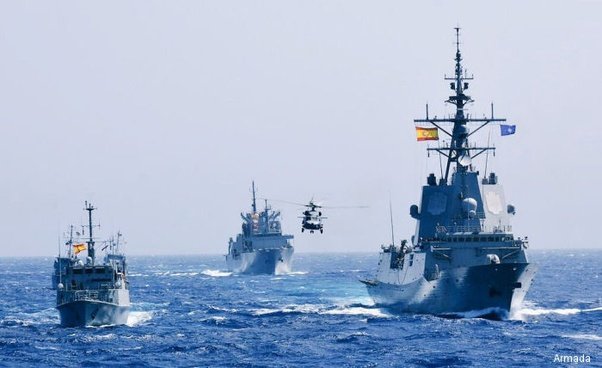
Amphibious Warfare: Spain has a decent amphibious force including an LHD and two LPDs, both similar in design to the British Bay-class LSDs. This allows a permanent basic amphibious element to be available through the LPDs however the LHD, already limited in availability as it does not have a sister ship, often fulfils a carrier role as well. Air Defence: Spain’s air defence comes from both its carrier and destroyers. Currently there are five destroyers in service with somewhat older air search radars but relatively standard air defence missiles. The carrier can have an air wing of up to 13 AV-8B Harriers, though with maintenance accounted for it might only hold about 6–8 at a time. Still, with light AEW support and long range AAMs these provide a decent level of air coverage. Combined with the number of AAW. destroyers it provides a decent force. Anti-Submarine: Spain is slightly limited in the anti-submarine field. Of its 11 surface combatants, only the older frigates (based on the Oliver Hazard Perry from the 70s) have towed sonars and limited ASW engagement options. Despite their age, these ships on their own provide a basic capability, however the supporting submarine force is extremely limited with only two submarines based on a 70s/80s design. These will be replaced by a more numerous class eventually but for now Spain is falling behind here. Land-Attack: For land-attack operations Spain doesn’t have any cruise missile-equipped warships or submarines however with a carrier operating AGMs and bombs, it still has a reasonable capability when available. Anti-Ship: The carrier has basic anti-ship options and warships have a defensive option but with the lack of submarines the navy is in a weaker position currently. General Patrol: Spain has numerous patrol ships and craft and is one of the most capable nations in this area, only behind France and Italy. Auxiliary: Spain’s auxiliaire force is very similar in overall size to Italy with about the same total displacement. It had two larger tankers and a medium transport ship. The tankers allow long range support for Juan Carlos I but no further support. Italy on the other hand has a bit more versatility, allowing for small scale additional operations at sea, even if the carrier tankers may need to resupply more. Voyenno-Morskoi Flot (Russia) Summary: The Russian Navy is very different from any other navies here as it isn’t western and uses its own technology. Due to the economic difficulties Russia has faced since the collapse of the USSR - particularly in the 1990s and 2000s, it didn’t see much modernisation. Since Russia has to use its own technology in most areas, it is still spread out with some advanced in specific areas but generally it continues to trail behind some counterparts, even with a large size.
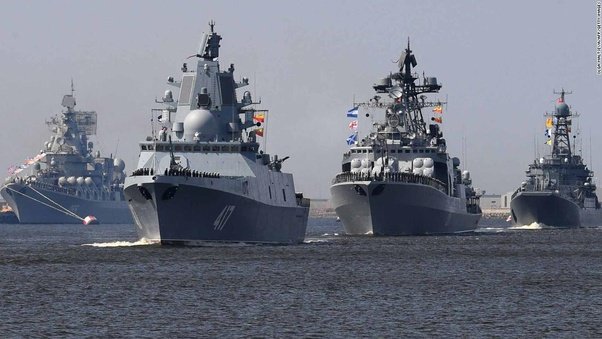
Amphibious Warfare: Russia has a large number of multipurpose landing ships from the 1980s. These are interesting ships that typically carry a couple companies of soldiers and have various basic weapon systems for fire support at short ranges, however they aren’t generally designed for long range use and only to move troops around different regions within and around Russia. Air Defence: Unlike the other nations here, Russia does not have specialised AAW warships with its destroyers are frigates being directed towards ASW/AShW while cruisers, the only vessels with capable air defence missiles, have old radars with limited range. With the carrier out of service that doesn’t provide much additional benefit either. Still, through sheer quantity Russia does have a degree of capability here. Anti-Submarine: 7 specialist ASW frigates and many additional warships with Variable depth sonars. Again, quantity helps the Russian Navy in this respect as most smaller boats have hull-mounted sonars and ASW mortars/torpedoes for short range engagement. With a vast submarine fleet - particularly the Akula-class - Russia is in strong contention for the most capable ASW fleet. Land-Attack: With the carrier out of service and the surface vessels primarily focusing on other roles, most of Russia’s land attack capabilities come from its submarine fleet. Many of the larger submarine classes have numerous cruise missiles although many are used for anti-ship roles and even the ones that aren’t are ultimately restricted to precision strikes. Anti-Ship: Undoubtably, Russia places a massive emphasis on anti-ship warfare both with its countless submarines and surface vessels. Even with many ins states of disrepair, the combined quantity is far greater than any counterparts. General Patrol: Although Russia has many corvettes, frigates and missile craft that would be the ideal size for patrol operations, these are generally focused on more conventional warfare platforms such as anti-ship and submarine missions. The dedicated patrol force is smaller, mostly made up of small craft for coastal security and border force vessels. Auxiliary: Russia’s main weak point is in power projection and a significant element of this stems from their limited refuelling fleet. They have many auxiliaries for broader logistics roles such as salvaging duties, tugs (lots of those), and general transport missions, however for long range at-sea replenishment they have only one vessel built in the last 35 years - a relatively small 14,000t tanker that just entered service this year. They have two more 9,000t tankers from 1982 and everything else is amor the 1970s, 1960s or sometimes even earlier. Deutsche Marine (Germany) Summary: Germany is the only country here without some kind of carrier/amphibious capability (even if they don’t work like with Russia) and as a result they lack any expeditionary capabilities, however they have a strong and modern surface fleet.
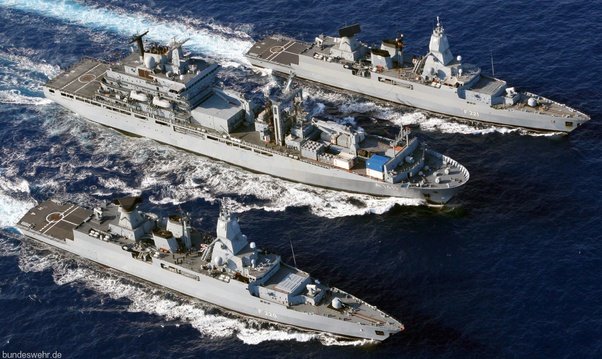
Amphibious Warfare: Though it shares one LPD-type vessel with the Netherlands, Germany as a whole lacks the necessary facilities or experience for longer Ange operations with amphibious warfare. Air Defence: Germany’s air defence squadron is relatively advanced with three specialist air defence destroyers. It does not have a carrier like many other states listed here however as a result it’s destroyers also have a greater flexibility to operate independently. If you look at France, for example, they have capable air defence from their sole destroyer but can’t deploy vessels anywhere else at the same time. Anti-Submarine: Germany’s current class of four ASW specialists are beginning to age with the new replacement class not arriving until the late 2020s, however these ships will be extremely capable and sophisticated at potentially 10,000t in total displacement. Even without them, the Type 212 submarines still provide decent ASW capabilities in the North Sea and Baltic. Land-Attack: Germany’s non existent carrier and force projection capabilities limit its land-attack role somewhat, however their submarines can carry some short range cruise missiles and the Baden Württemberg-class excel in this role with 8 long range cruise missiles and model Italian 127mm guns using guided shells with a 120km range. These are essentially litghtweight cruise missiles with 56 stores in the immediate magazine. Through these combined elements, it is certainly a contender for fourth overall against Spain which has a light carrier with a dozen harriers but these jets are getting old and the ship is only available irregularly. Anti-Ship: Again, Germany has no carriers or heavy airborne assets and so is naturally limited there, however the country does have an extremely strong submarine industry, selling more than any other nation on the planet. Naturally this leads to them developing an advanced model of SSKs, though even with 6 in service these vessels are relatively small and limited in range. General Patrol: Germany doesn’t generally have any patrol ships though some of its frigates are largely used in a patrol role along with 5 corvettes with 5 more entering service at some point in the future. For now I wouldn’t put them as high as other with large numbers of GP frigates and OVPs, but with the corvette expansion it could dramatically increase capabilities eventually. Auxiliary: Germany’s auxiliary fleet is surprisingly large compared to competitors - being twice the size of France and larger than any others aside from Britain (still by a significant margin). It has five relatively small tankers of 14–20,000t which could sustain two small surface flotillas of a couple warships each along with six smaller 3,500t support ships. These vessels are interesting as they are nowhere near large enough to sustain major vessels, but are perfect for occasionally resupply Germany’s relatively small submarines or support a flotilla or patrol craft of mine hunters and they have naturally been arranged as such, attached to different squadrons to whom they can offer food, fuel and ammunition. Overall Ranking: Amphibious Warfare: 1st: United Kingdom 2nd: France 3rd: Italy 4th: Spain 5th: Russia 6th: Germany Air Defence: 1st: United Kingdom 2nd: France/Italy 3rd: ^ 4th: Spain 5th: Germany 6th: Russia Anti-Submarine: 1st: Russia (assuming all ships are being reliably maintained) 2nd: UK/France 3rd: ^ 4th: Italy 5th: Germany 6th: Spain Land-Attack: 1st: United Kingdom 2nd: France 3rd: Italy 4th: Germany 5th: Spain 6th: Russia Anti-Ship: 1st: Russia 2nd: UK/France 3rd: ^ 4th: Italy 5th: Germany 6th: Spain General Patrol: 1st: France 2nd: Italy (possibly moving to 1 soon) 3rd: Spain 4th: UK 5th: Germany 6th: Russia Auxiliary: 1st: United Kingdom 2nd: Germany 3rd: France 4th: Russia 5th: Italy 6th: Spain 40.6K viewsView UpvotersView Sharers